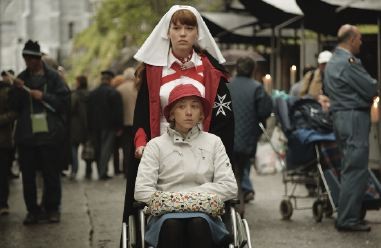Lourdes

When Pandora opens the box that contains all the world’s evils, they immediately fly away, destined to plague humankind for eternity. She is able to replace the top just in time to save only hope. But why was hope among the evils in the first place?
The new French-language film Lourdes, written and directed by Austrian filmmaker Jessica Hausner, takes up this question. For where on earth is hope more powerful, or ultimately more diabolical, than at the religious shrine in southwest France, in the foothills of the Pyrenees? Since 1858, when Bernadette Soubirous supposedly encountered the Virgin Mary there, Lourdes has been synonymous with hope and all the spiritual hunger that comes with it: believers come to be healed in the waters from the spring where Mary is said to have appeared. By taking us on a pilgrimage to Lourdes—as one of the thousands that come there each year from every corner of the globe—and walking us through some of the steps that such a pilgrimage involves, Hausner suggests just how terrifying and malignant hope can be.
The tour guide on this Dante-like journey is Christine (Sylvie Testud), a middle-aged woman stricken with multiple sclerosis. Not only must she get around in a wheelchair, pushed along by an aide or a kind soul, but she needs help with all of her bodily functions. As she listens to the prayers, hears the pleas and bathes in the holy waters of the spring, Christine seems acutely aware of the sadness and desperation around her.
Christine doesn’t have high expectations for divine intervention. Like a character in a film by Ingmar Bergman or Carl Dreyer, her faith is in question. She goes on the occasional pilgrimage, she tells someone, just to get a chance to take a vacation. Seeing Lourdes and other shrines from a wheelchair is better than staying home.
Her spot in the chair also allows her to consider the other key characters in the story, who represent various aspects of human nature: the confused priest, the seductive soldier, the stoic nun, the distracted aide, the tortured mother and—more cryptically—the silent old woman who is neither sick nor lame but goes on these journeys to find meaning in a solitary life. (Did she once lose someone herself? Or was she perhaps the recipient of an earlier miracle? The film never says.)
As the crippled and ill hobble up to be blessed and bathed, Christine hears the entreaties ring out: “What must I do to heal my broken body?” “If I am not healed this time, does that mean my faith is wanting?” “Should I pray more and come back again?” “Why is she healed when I am not? Aren’t I more pious? What does she know that I don’t?” “Why won’t you bless me, oh God?”
Hausner has called Lourdes “a cruel fairy tale,” and it would be easy for her to dismiss the shrine as a moneymaking scam, thick with souvenir shops hawking plaster Madonnas and low-end rosaries. But Lourdes is deeper and richer than that. Miracles do occur at Lourdes. People have been healed. But why? Is it faith alone that drives the cure? And if so, if the miracle suddenly ends, does that mean that their faith is no longer enough? Is it God’s curious sense of justice or just an ugly twist of fate?
Hausner frames her story and the obvious questions that accompany it with a low-key cinematic style that harkens back to Robert Bresson (Diary of a Country Priest). This is especially true in the way she uses Testud’s sweet face and cryptic Mona Lisa smile as the touchstone for the film. It resembles a painting from the Renaissance, a visage searching for more than what the canvas can hold.





